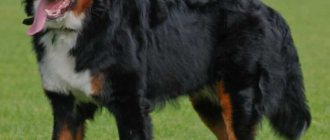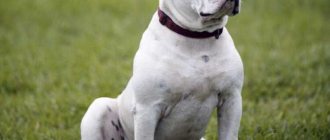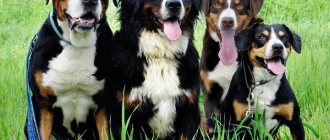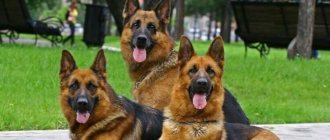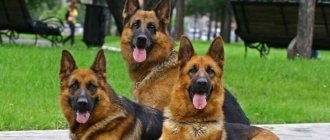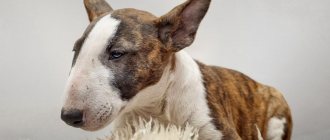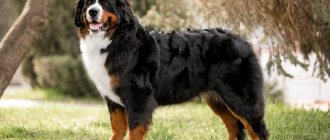Review author: “ZooVita”
Bernese Mountain Dogs originate from Switzerland, where they are highly valued not only as companions and pets, but also as working dogs. In their homeland, they are classified as Mountain Dogs and are known as true gentle giants, especially good with children of all ages.
History of the Bernese Mountain Dog breed
Bernese Mountain Dog
The distant ancestors of today's Mountain Dogs are considered to be Molossians, which were bred by the ancient Romans. Representatives of this breed were considered all-round dogs, since each individual combined fighting, herding and guard qualities. Molossians also accompanied the Romans on military campaigns, which helped the dogs reach the Alps and leave offspring in the territory of modern Switzerland, which gave rise to the family branch of the Sennenhunds.
Swiss peasants quickly appreciated the endurance and good-natured disposition of these large dogs, adapting them to work in cheese factories and transport milk along mountain trails. Until the middle of the 19th century, Mountain Dogs regularly grazed cows on alpine lawns, working part-time as dairy product distributors, but they were soon forced out of this niche by Saint Bernards. In some remote areas, the descendants of the Roman Molossians were still bred, but not so zealously, which is why the famous tricolor color was becoming less and less common among animals.
For a long period of time, Swiss Mountain Dogs were equated with mongrels and were not listed among breeders. Only at the end of the 19th century did these dogs begin to attract the interest of specialists, which became the main impetus for the emergence of the branch of Bernese Shepherd Dogs. The fundamental role in the formation of the breed was played by the Burdorf winemaker F. Schertenleib. The entrepreneur fell in love with Alpine dogs so much that he tirelessly traveled around the province of Dürbach in search of suitable “specimens” for his kennel.
The name “Bernese Mountain Dog” was given to this branch by Professor of the University of Zurich Albert Heim, who also formulated its main “identifying features”. Well, in 1907 the first breed standard was adopted, which, in fact, was a pure formality. As a result, Bernese Mountain Dogs were exhibited in European salons for quite a long time without pedigrees or registration numbers.
An interesting fact: in the 40s of the 20th century, as a result of an accidental mating of a Bernese Mountain Dog with a Newfoundland, Swiss Cattle Dogs were able to improve their natural performance. For example, Bernese Shepherds have acquired shinier and longer hair, and their temperament has become more phlegmatic.
The peak of Bern's popularity occurred in the 80s of the last century. Calm and friendly shepherd dogs enjoyed constant prestige among European and American breeders. Representatives of this breed were brought to Russia from Hungary, Poland, Czechoslovakia and Germany.
Reviews from Bern owners
“As a puppy, our Maggie quickly learned not to dirty the house, and since then she continues to amaze us with her intelligence. Allows the youngest to hold on to the fur, licks his legs. He plays tug of war with his adult daughter, brings fetch, sometimes they just run around the site together. Our family would not be complete without this dog, I don’t know how to explain.”
“I lived with a Bern, and I can say that this is the best dog of all. Byron was a calm, obedient dog. Kind as a felt boot. He got along with cats and adored children. Veta was afraid like fire - he would come to give vaccinations, and this carcass was hiding behind me, they laughed until they cried. Only he lived only 7 years. Shoulder sarcoma, nothing could be done. Now I'm afraid to get a dog of the same breed - maybe again. It was too bitter to part."
“Bern is a giant teddy bear! My affectionate as a cat, I have never noticed any signs of aggression towards anyone. He pushes around when he plays, it’s terrible, but how can you be angry with him? We took our Gordon with a faulty color - cheaper than others, what difference does it make to us. I've had a lot of trouble with wool, it's everywhere. But this is the only disadvantage of the breed."
“This is my first dog that guesses my mood and reacts to the slightest gestures. A true empath, a devoted friend. It seems that he loves his wife too, but I feel that this is my dog. He ruined our entire garden - he tramples the beds, breaks the bushes, digs. Even so, the neighbors are vying with each other to ask when Tyson will have puppies.”
“It was scary to take such a big dog into the apartment, but we just couldn’t resist! Now our Alpha is three years old and most of the time he sleeps and does not shine. Maybe we came across such a fool, but the repairs are intact, the dog is content with two long walks, everyone is happy.”
Appearance of Bernese Mountain Dogs
Bernese Mountain Dog puppy at 6 weeks
Bernese Shepherds are fairly large dogs with long black and fawn hair and white spots on the nose, neck and paws. The breed is considered to be the so-called “smile” Bernese. In a calm state, the muscles of the dog’s muzzle and head relax, opening its mouth slightly and creating the illusion of human facial expressions. The reference height at the withers for males is from 64 to 70 cm, for females - from 58 to 67 cm. The average weight of the Bernese Mountain Dog ranges from 39-50 kg for males, 38-48 kg for females.
Head
Proportional, large. The skull is massive, rounded, which is especially noticeable when looking at the animal in profile. The frontal groove is not clearly expressed. The transition from the frontal part to the muzzle is smooth, without sharp lines. The nose is large, black, with large nostrils.
Jaws and teeth
The standard bite is a scissor bite, but in some cases a pincer (straight) option is also acceptable. The teeth of the Bernese Mountain Dog are large, strong, and located in one line.
Eyes
The eyes are medium-sized, almond-shaped, set straight. The shade of the iris is dark brown, the whites of the eyes are not noticeable. The eyelids are dry and black (“damp” eyelids are considered defects).
Ears
Medium size, regular triangular shape, set high. At rest, pendulous, the tip of the ear is slightly rounded. When the Bernese Mountain Dog is alert, the front of the ear continues to remain flat against the skull, while the back of the ear is raised slightly.
Neck
Medium length, muscular, with a prominent scruff and well-developed withers.
Bernese Mountain Dog muzzle
Body
The body is compact, strong, with a wide, straight back and a deep, long chest. The ribs are convex. The loin is short, slightly narrower than the chest and croup.
Limbs
The Bernese Mountain Dog's forelimbs are straight, even, and set wide apart. The shoulder blades are elongated, tilted back. The humeroscapular angle is usually 100°. The hind legs are straight, strong, and muscular. The thighs are elongated, with developed muscles. The hock joints are strong, with a pronounced angle. Dewclaws (rudimentary finger-like processes located above the paws of the hind legs) in purebred individuals must be removed. The paws are directed forward, rounded, with elastic pads. The hind legs are collected into a less prominent “lump” than the front legs.
Tail
The tail of the Bernese Mountain Dog is massive, saber-shaped, tapering from the base towards the end. In a calm animal it is lowered, in an excited animal it rises to the level of the back and higher.
Wool
Long, straight, with a spectacular shine. May have slight “waves” in places.
Color
The predominant body color of the Mountain Dog is black. Areas of rich fawn coat are located on the chest, all four legs and above the eyes. White markings in Bernese Shepherds can be on the head in the form of a groove (should not reach the fawn areas of the coat), on the muzzle in the form of a spot (should not extend beyond the corners of the mouth) and chest. White “socks” on the paws and a white tip of the tail are also considered ideal parameters. The presence of small white “fragments” in the back of the head and anus is acceptable.
Major vices
Bernese Mountain Dog paw
Bernese Mountain Dogs may have deviations from the breed standard:
- too light frame;
- incorrect placement of incisors with correct bite;
- curly wool;
- the absence of white “flaps” on the head, as well as their excess quantity;
- black body color with a pronounced brown or red undertone;
- color asymmetry;
- the white areas of the coat have a grayish tint.
To disqualify a show class animal, the following defects are sufficient:
- progenia (overshot) or undershot;
- entropy (inversion of the eyelid);
- creases in the tail, or a tail curled into a donut;
- split nose;
- short coat, or the so-called “double coat” (when the undercoat “eclipses” the guard hair);
- aggression or cowardice of the animal;
- cryptorchidism;
- insufficient growth.
Vaccinations
The health and even the life of your pet depends on timely vaccination
The first vaccination for a puppy is carried out at the age of 1.5 - 2 months. As a rule, a polyvalent drug is used that protects against hepatitis, leptospirosis, and parovirus enteritis.
At six months of age, a comprehensive vaccination and vaccination against rabies is carried out. Similar procedures are carried out for a one-year-old dog.
Subsequently, vaccinations must be done annually. Don’t forget about periodic, usually seasonal, treatment of Burns for fleas and ticks.
The price of medicines is constantly changing, but vaccination can protect your pets from serious diseases.
Photo of an adult Bernese Mountain Dog
Personality of Bernese Mountain Dogs
Bernese Shepherds are extremely kind, obedient and devoted friends who will not harass their owner with demands for increased attention and a violent temperament. Berns are calm and infinitely wise, but at the same time they are not “crackers” and are quite capable of expressing feelings. Representatives of this breed are typical family dogs. By the way, despite the fact that Mountain Dogs are not considered ideal nannies, they treat children patronizingly, with a sense of slight superiority, and do not respond to annoying pranks with aggression.
Bernese Mountain Dog with a child
Young individuals are usually very inquisitive and a little careless, they allow themselves to fool around in moderation, but do not go too far. Adult and experienced dogs are calmer and more phlegmatic. These imperturbable giants will no longer be fooled by a cat running across the road or other simple provocations. Bernese Mountain Dogs love to play as helpers, guides and guards. They are happy to carry their owner's small purchases or protect him from other dogs. Burns also make excellent animators: teach your pet to walk in a sled, and he will be happy to push your children in a cart. The legendary fearlessness of the Berns brings them more trouble than good. Representatives of this breed often perform unnecessary feats, such as jumping from a balcony, which end in failure for the dog itself.
In general, Mountain Dogs are patient and affectionate, respectful of people. Speaking of respect: Bernese Shepherds treat strangers calmly, without showing aggression, but also without much sympathy. Usually only one family member becomes the most respected in the eyes of the animal. This, of course, does not mean that the dog does not obey other people. It’s just that the pet will not carry out the commands of the “secondary” owners as actively. Despite the slight laziness and love of sleep that periodically descend on representatives of this breed, Bernese gladly take part in outdoor games. True, due to their nature, they don’t like to have fun for too long.
Psychology
Calmness, balance, sobriety of actions - this is all about the Greater Swiss Mountain Dog, with proper training, of course. Medium or moderate temperament, like a Bullmastiff or Tosa Inu , but not phlegmatic.
Grosses are quite cheerful, and they are also perky and cannot be called lazy. They can be trained easily. The only character trait that can interfere with training is stubbornness. If a dog is tired of something, he can simply lie down and flatly refuse to follow commands.
It depends only on you how the mountain dog will grow up and what kind of character it will have.
But the owner’s love is always able to find workarounds through the stubbornness of Sennenhunds. It is important to note the late maturity of the breed, which is also a distinctive feature of German boxers .
Even dogs that appear to be adults can turn out to be cheerful, positive puppies who want to play all day long. Gross easily gets along with children and other pets. Although he does not always listen to children.
This is interesting! It has not been precisely proven, but it is generally accepted that the Greater Swiss Mountain Dog is attached primarily to its owner. Therefore, if there is this dog in the house and he sees you for the first time, be careful in communicating with the owner of the gross.
The Sennenhund is a pack breed. Therefore, if he is alone in the family, then you automatically become his family. It is important to teach your dog to obey every family member from the very beginning.
Subsequently, the dog will develop an individual relationship with each of you. Also remember that this is a large mountain Swiss that needs a lot of free space and movement. When living in an apartment, daily walks and physical activity are a must!
This is interesting! The Greater Swiss Mountain Dog is used to working, so give him this opportunity. Let it be a game . This way the dog will not be sad and waste away without realizing his skills, which are in his blood and passed down from strong and strong-willed ancestors.
The psyche of Greater Swiss Mountain Dogs is stable. If a dog shows excessive aggression or behaves too fearfully and timidly, then this is the result of improper upbringing and insufficient socialization.
Important! Under no circumstances should you put a gross on a chain.
Education and training
Bernese Mountain Dogs require mandatory socialization, and the sooner you start teaching your puppy commands, the better for both of you. Despite their calm appearance, Bernese Shepherds are very sensitive dogs, so you should not shout at your pet, or use physical violence towards him. In education, it is recommended to show a certain firmness and perseverance: for mistakes, the puppy should be given suggestions in a strict tone (the punishment system for small puppies, as a rule, is not applied).
Mountain dog training
The age from 4 to 8 months is the period of maximum disobedience and pranks. At this time, the dog is teething, so Bernese Mountain Dogs actively taste the surrounding reality. Sometimes the object of attention becomes not only slippers and shoes, but also the fingers of family members. In order not to stock up on iodine and bandages later, teach the dog not to consider the owner’s hands as an object for play. If the puppy does start biting your fingers, lightly pinch his nose. The pain will sober up the animal and will not cause any significant harm to it.
From the first months of life, begin to gradually wean your dog from spontaneous jumping. While the animal is small, such an expression of tender feelings causes sincere affection, but when, after a couple of years, a shaggy 50-kilogram carcass jumps into your arms, it will cease to be a pleasure.
Important: Bernese Mountain Dogs mature later than other breeds, so complex training should only be practiced with individuals who have reached the age of two.
You should start training your pet by wearing a collar and the simplest commands “Come to me!”, “Ugh!” and others. Even an animal one and a half months old can learn these simple lessons. Spend 10 to 15 minutes on training. per day to avoid overtiring your puppy, and be sure to use tasty rewards, either purchased from a pet store or homemade. And under no circumstances overdo it. Discipline should not turn into a set of prohibitions that restricts the pet’s freedom: after all, for normal development, the puppy needs to come into contact with things and other animals as often as possible. Those who see their Bernie as a future watchman should develop the dog’s ability to divide people into friends and foes. This also includes such a skill as refusing to accept treats from the hands of a stranger. Exceptions are unacceptable even for “good friends”.
Mating
Grosser takes a long time to mature. It reaches full maturity by 2-2.5 years. Although the first estrus in females occurs before the age of one year.
Estruses recur every 6-9 months. Pets are untied from the 3rd or 4th heat. The mating is carried out on the territory of the male dog, having previously introduced the pets.
Pregnancy lasts 56-72 days. The more puppies in the litter, the longer the dog carries them. Childbirth usually takes place without problems, bitches give birth from 1 to 8 pups.
Care and maintenance
I am a pirate!
A home for a Bernese Mountain Dog can be either a village cottage or a city apartment. For individuals guarding a private home, it is more advisable to build housing in the courtyard. Usually, the shepherd dogs are fenced off with an enclosure in which a booth is installed. If your pet will live in an apartment, it is best to give him a corner on the balcony (provided that it is glazed). To prevent the animal from freezing in the off-season, you can set up a small kennel on the balcony.
In the summer, it is also necessary to monitor the temperature on the balcony: the sun strongly warms up the walls of the house, which does not have the best effect on the dog’s health. For those who plan to keep a Bernese in an apartment, it makes sense to take care of purchasing a playpen in which to place the dog in case of your own absence. It is better to place it away from radiators and heating devices.
Bernese Shepherds are supposed to be walked twice a day, and it is advisable to combine walking with active physical activity. You can get your dog to run or take part in some simple play to burn extra calories and improve muscle tone.
Hygiene
Since Bernese Mountain Dogs shed heavily, they need to be brushed every day. But you shouldn’t bathe your dog too often. A bath day for representatives of this breed is held no more than once a month, except in cases where your pet managed to get thoroughly dirty during a walk. It is advisable not to wet the animal’s head at all while washing it to avoid water getting into the ears. Shampoo is used as needed and in very limited quantities; a hair dryer is used only for drying adults. After bathing, remove excess moisture from the coat with a towel and make sure that the animal does not sit in a draft until it dries. After drying, the wool is combed.
The Bernese Mountain Dog's ears should be examined once a week. If you are walking an animal in a forest belt, it is better to check it after each walk. Contaminants from the ear funnel are removed using a cotton pad moistened with boiled water. It is not recommended to use cotton swabs to avoid damage to your hearing. Bernese Mountain Dogs should have their nails trimmed once every two weeks. Removing yellow plaque from the surface of the teeth is done with a special paste applied to a cotton swab 1-2 times a week.
Feeding
Two-month-old puppies are fed up to 5 times a day, three-month-old puppies - 4 times, seven-month-old adolescents are transferred to three meals a day, and by the age of one year the dog should eat twice a day. An animal under two months of age should receive fermented milk products such as cottage cheese, curdled milk or kefir every day. Pure milk is not allowed. Meat is introduced into the Sennenhunds’ diet gradually, in combination with boiled cereals and vegetables.
Omnomnom
The “menu” of a natural-fed adult must include lean meat or offal, sea fish fillets (frozen), and fermented milk products. It is recommended to give vegetables (carrots, pumpkin, broccoli) along with meat, and for “dessert” you can pamper your pet with a piece of banana, apple or pear. The amount of cereal products consumed by the animal should be at least 10% of the total diet. A couple of times a week, you can treat your Bernese Mountain Dog to a raw yolk or hard-boiled egg.
Owners who prefer to feed their pet “dry food” should take care of looking for food with low fat content (no more than 16%) and with a protein content of 18 to 26%. Try to choose varieties that do not contain soy, corn or wheat. A healthy adult animal should consume from 1800 to 3000 kcal per day, a two-month-old puppy should consume about 600 kcal, while an older, inactive dog will need 1500 kcal.
Toilet
To toilet train the Bernese Mountain Dog, it is usually walked after meals. If the puppy did not wait for a walk and made a puddle in the apartment, it is useless to scold him. But patience and the fulfillment of natural needs in the right place are worth rewarding. In the first months of life, the puppy needs to be taken outside more often in order to catch the moment when he wants to relieve himself. An adult animal, whose skill has already been formed, is able to endure. As for the indoor toilet, rubber mats, newspapers or diapers are usually used for such cases to help keep the floor clean.
Walk
Particular attention should be paid to physical activity. Unlike similar dog breeds, the Bernese does not need a large number of them.
You can just take a long walk with your pet, go for light jogs from time to time, and play with him.
Important! For the Bernese Mountain Dog, the main thing is the company of the owner and his attention. No matter how energetic your walks are, the most important thing is that you are nearby.
The game with a stick, shown in the photo, is one of the favorites of this breed.
Bernese Mountain Dog Health and Diseases
Bernese Mountain Dog with cat
Bernese Mountain Dogs are dogs with good heredity, but a constant companion of “apartment” dogs – physical inactivity and constant stress can seriously undermine the pet’s health. The average lifespan of a Bernese Shepherd is 8-10 years. In the absence of serious diseases and quality care, some representatives of this breed “hold out” to their 13th birthday, which is considered a kind of record.
Typical diseases of Bernese Mountain Dogs:
- dysplasia of the elbow and hip joints (not a death sentence and, with well-chosen treatment, may not cause discomfort to the pet);
- osteochondrosis of the shoulder;
- problems with the visual organs (cataracts, entropion, retinal atrophy);
- alopecia (hair loss, baldness of the animal);
- weeping eczema;
- umbilical hernia;
- overheating (heat stroke).
Like representatives of many other breeds, Bernese are susceptible to cancer. In addition, some individuals may exhibit hereditary kidney pathologies.
Application
During World War II, the Swiss army actively used Gross dogs as draft animals. Indeed, they had all the makings for this.
Not only does the gross easily pass where the path is closed for a horse, but it also has good endurance and strength for dragging 10-kilogram loads over long distances.
It is worth noting that at that time the breed was not yet fully formed.
In such a harness, the big Swiss feels confident: he inherited this from his ancestors
The ancestor of the Greater Swiss Mountain Dogs is a dog named Barry von Herzogenbuchsee. Over the 10 years from 1912 to 1922, 11 dogs were entered into the pedigree book. The correct color from the point of view of this breed was developed after the war, in 1956.
During the fighting, the number of grosses was about a hundred individuals, and by the 50s this figure decreased again. Only thanks to the growing popularity of the breed in Germany, and then in other countries, today the number of representatives of the breed is very impressive.
Large Swiss Mountain Dogs are capable of competing in various dog sports and obedience. Thanks to their love of work, Grosses do an excellent job in the field of training.
Their strong spirit requires the same spirit from the trainer. However, there is a detail that makes them unsuitable for hunting and agility - their heavy weight and large dimensions.
Important! Grosses, like Alabais , do not tolerate harsh treatment: it can lead to the complete disappearance of positive traits in the dog’s character.
How to choose a puppy
Bernese Mountain Dog puppies should be adopted between the ages of 2 and 6 months.
Males of this breed look more impressive due to their impressive size, but are more difficult to train. Females are more flexible and intelligent, but during the period of heat, an irresistible “craving for travel” awakens in them, which can become a serious problem for the owner. Be sure to evaluate the situation in the nursery by looking into the enclosures where the animals live and carefully studying their standard menu. Getting to know the puppy’s parent, as well as his veterinary record, will also not be superfluous. The greatest demand is for frisky, playful and inquisitive puppies: this behavior signals that the animal is healthy and kept in acceptable conditions. At a young age, Bernese dogs may have a modified coat structure: it may be too straight or, conversely, curly, and also have a grayish undertone. All these features are not considered defects and disappear with age.
Nutrition
The Greater Swiss Mountain Dog's diet is approximately the same as that of other large dog breeds. It is selected individually. It is worth relying on the dog’s lifestyle and degree of mobility.
It is important to follow a diet, that is, feed your pet at the same time and in the same place.
He is either stubborn or resting after a long active walk
Important! Grosses are very voracious, but make sure that there is no overfeeding, because this is a direct risk of obesity and acute bloating, and in the latter case, surgical intervention may be required.
Since Grosses are notorious for diseases of the musculoskeletal system, the diet must contain the components necessary to prevent such problems. Dry food can be given, but in moderation.
In any case, when preparing a diet for the Greater Swiss Mountain Dog, it is necessary to consult with specialists and those who have been successfully breeding dogs of this breed for a long time.
